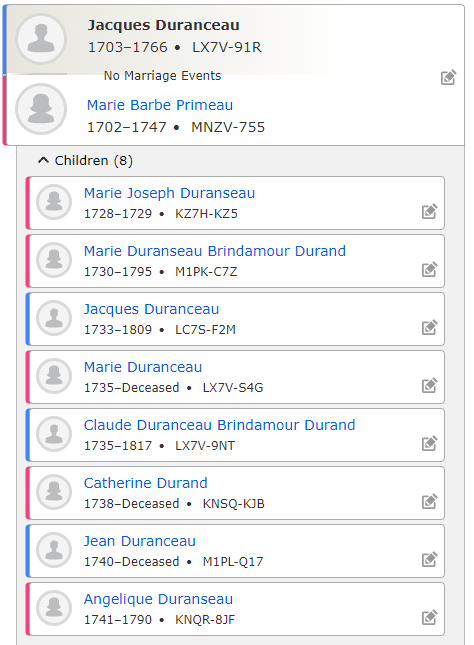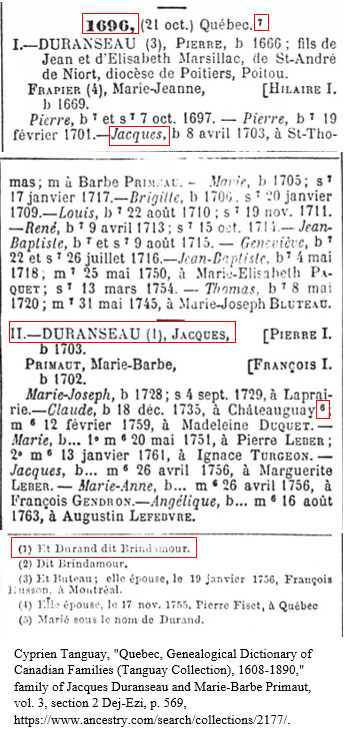Canadian Research Part 1 : Genealogy of Canada & Tanguay
 3
3Sep

Compiled sources, though not always reliable, can be a good place to gather starting information on your ancestors. An obvious example of these sources are online trees on websites such as Ancestry and FamilySearch. However, there are other compiled sources that can be useful to your French-Canadian research. This post will cover two Canada genealogy sources: Genealogy of Canada and the Dictionnaire généalogique des familles canadiennes (Genealogical Dictionary of Canadian Families).
Tanguay and Canada Genealogy
Genealogy of Canada
Genealogy of Canada has a free, online database of genealogical information on Canadian families. This source is useful because of its narrow focus on Canada; you will have less information to sift through to identify your ancestors.
I wanted to see if there was an entry for the family of Jacques Duranceau that I had on FamilySearch Family Tree:

This is the entry I found. As you can see, anyone can edit this page, so it functions similarly to FamilySearch Family Tree through crowdsourcing. However, it gave me several pieces of information to compare with the entry on FamilySearch. The biggest discrepancy I noticed was that on FamilySearch Jacques and Barbe have eight children, but on Genealogy of Canada they have six.

Since these publicly sourced trees did not agree, I moved on to another compiled source that can be more reliable for French-Canadian research.
The Tanguay Dictionary
A useful resource in French Canadian research is the Dictionnaire généalogique des familles canadiennes (Genealogical Dictionary of Canadian Families) published by Cyprien Tanguay in the late 1800s. He conducted extensive research in the archives and parish records of Québec, the Maritime Provinces, Ontario, French settlements in the United States, and France. Through these efforts, he was able to trace many French-Canadian families back to France. His dictionary has some errors but is a wonderful place to obtain starting information on your French-Canadian ancestors.
Each entry is a family pedigree with baptism, marriage, and burial dates and locations for members of the family. The entries are organized by the husband’s surname alphabetically and a new entry is indicated by a bolded year, which is the year the husband first married. Each entry typically contains:
- The husband’s name, baptism, marriage, and burial information as well as his parents’ names.
- The wife’s name, baptism, marriage, and burial information as well as her parents’ names. If the husband married more than once, the wives are listed in chronological order.
- Children are indicated with italicized names and may have baptism, marriage, and burial information.
- Roman numerals indicating how many generations there are between the husband and their French immigrant ancestor.
- Abbreviations:
- b: baptism or christening date
- m: marriage date
- s: burial date
- “Superscript numbers: these represent a place within the family record; for example, if a superscript 3 follows Quebec at the beginning of the record, whenever a superscript 3 appears in that record, it means the event took place in Quebec. Note that this is only applicable within the particular family record and not throughout the book. In another family record, a superscript 3 might stand for another place.”[i]
You can access this dictionary as books or microfilm at the Family History Library in Salt Lake City, Utah or online through Ancestry here. This post will demonstrate how to navigate the dictionary online.
Returning to the family of Jacques Durancea, I conducted a search in the dictionary to see if I could locate him using the following search terms: Jacques Duranceau born 1703. However, I got no results. So, I tried another variation of his surname, Duranseau, and found this entry:
 The entry begins with the bolded year 1696, the year Pierre Duranseau married. A superscript 7 follows the location of Québec, and the rest of the entry uses the superscript 7 to refer to that location. Jacques first appears in the entry as one of Pierre’s sons, then as the head of his family set off by the Roman numeral II. The (1) following his surname leads to a foonote that says “Et Durand dit Brindamour” which indicates Jacques had a dit name. You can read about dit names in our blog post How to Conduct your French Canadian Genealogy Research (Part One). Jacques’ list of children contains another example of the superscript number replacing a location; in this case superscript 6 represents Châteauguay.
The entry begins with the bolded year 1696, the year Pierre Duranseau married. A superscript 7 follows the location of Québec, and the rest of the entry uses the superscript 7 to refer to that location. Jacques first appears in the entry as one of Pierre’s sons, then as the head of his family set off by the Roman numeral II. The (1) following his surname leads to a foonote that says “Et Durand dit Brindamour” which indicates Jacques had a dit name. You can read about dit names in our blog post How to Conduct your French Canadian Genealogy Research (Part One). Jacques’ list of children contains another example of the superscript number replacing a location; in this case superscript 6 represents Châteauguay.
Even though much of the information in this dictionary entry matched what I found on FamilySearch, the Tanguay dictionary only listed six children for Jacques Duranceau and Marie Barbe Primeau, like Genealogy of Canada, where FamilySearch Family Tree claimed they had eight. The table below shows the discrepancy between the three sources and what was determined through research in original records. As you can see, FamilySearch Family Tree, Genealogy of Canada, and the Tanguay Dictionary were a mixture of accurate information and inaccuracies that could only be clarified by turning to original records.

All of the records needed to research the Duranceau family were in the Drouin Collection, a collection of original French-Canadian records that is invaluable to French-Canadian research.
As part one of a four-part series on French-Canadian genealogy research, this covers several tools that can assist you in seeking your ancestors. Part two explores how the Drouin Collection can assist you in tracing your French-Canadian roots.
Our professional genealogy researchers at Price Genealogy are available to assist you with your French-Canadian research. We would love to verify or extend your Quebeçois lines.
By Ariel
[i] “Quebec, Genealogical Dictionary of Canadian Families (Tanguay Collection), 1608-1890,” Ancestry, accessed August 13, 2021, https://www.ancestry.com/search/collections/2177/.
Photo: Pierre5018, CC BY-SA 4.0 <https://creativecommons.org/licenses/by-sa/4.0>, via Wikimedia Commons https://upload.wikimedia.org/wikipedia/commons/b/b9/Bernaches_du_Canada_01.jpg https://commons.wikimedia.org/wiki/File:Bernaches_du_Canada_01.jpg
